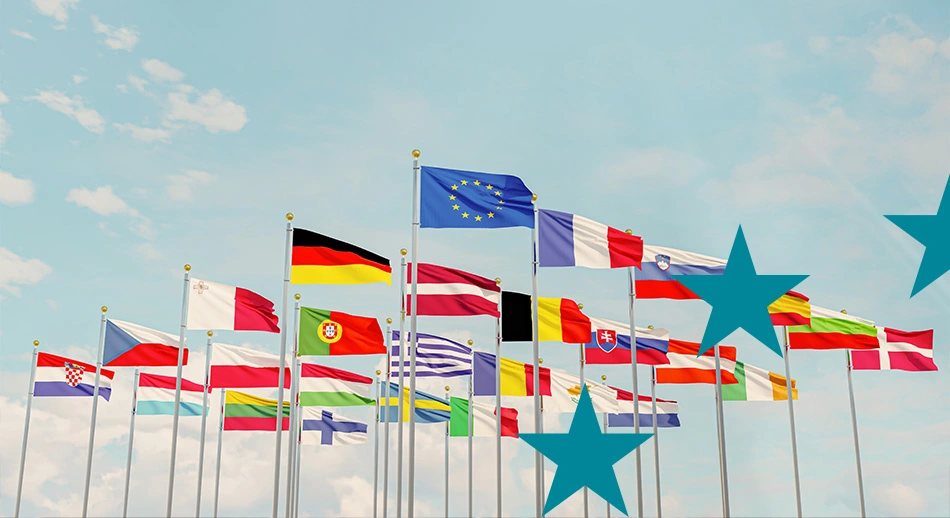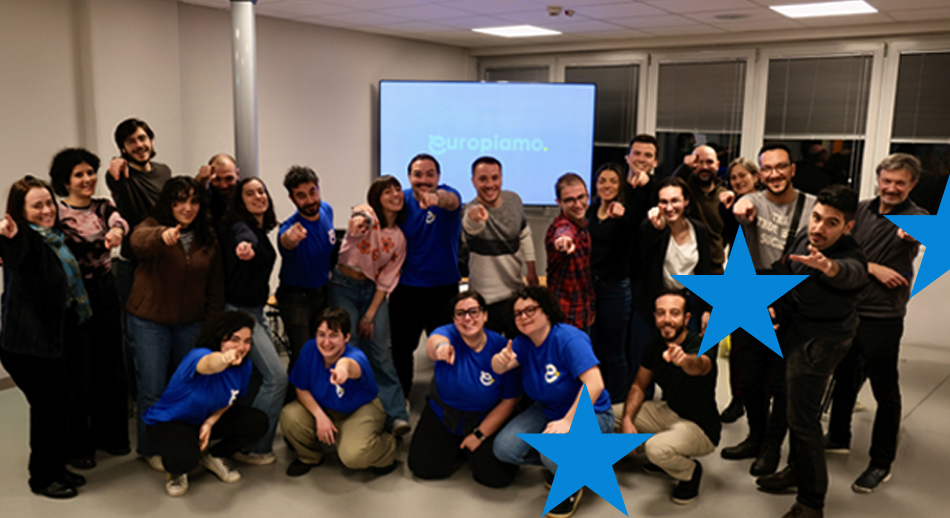Erasmus+ is one of the most representative programs of the European spirit. Let’s find out what’s changing and the next steps toward the 2028-2034 programming.
This article is produced in collaboration with Europiamo, an association established and run by young people to promote the opportunities offered by Europe to young people. Article edited by Federica Nestola.
Erasmus+: the history and evolution
In 2018, a Eurobarometer survey listed Erasmus+ as the EU’s fourth greatest achievement, right after freedom of movement, peace, and the single currency. This recognition is reflected in growing participation: in 2024, the program involved 16.5 million participants, double the number in 2014.
With the European Commission’s proposal for the seven-year period 2028-2034, Erasmus+ is at a crossroads: the program could take on a new shape, redefining priorities, structures and opportunities for students, young people and European organizations.
Let us review together the main stages of its evolution.
- 1987: Erasmus began as a university mobility program to promote cultural exchange and academic training. In its first edition it involves just 3,200 students.
- 1990s and 2000s: Erasmus expands its activities for young people and on nonformal education with initiatives such as Youth in Action, creating a European network of opportunities beyond the academic setting.
- 2014: Erasmus+ is born, integrating education, training, sports and youth under a single mobility and cooperation program.
- 2016: the European Solidarity Corps is established, promoting transnational volunteer projects to strengthen youth civic participation.
- 2021: The new Erasmus+ programming starts, with a strengthened budget and new priorities (inclusion, digital transition, and green). DiscoverEU, the initiative for 18-year-olds traveling in Europe, is officially integrated as an action part of the Erasmus+ program.
- 2022-2023: Actions for virtual mobility, blended learning, and innovative cooperative projects are strengthened, including as a response to post-pandemic challenges.
- 2024-2025: Growing focus on recognition of nonformal and informal skills, following up on what was done as part of theEuropean Year of Skills and the dedicated report of the Eurydice network.
This evolution consolidates the international dimension of the Program and the lifelong learning perspective, which makes it a particularly versatile program, open to everything that can be traced back to the different forms of learning. Erasmus+ is a program not only for students, but also for teachers, educators, adults, associations, universities, schools, training centers, realities of the world of work and sports.
Erasmus+: the European Commission’s new proposal.
On July 16, 2025, the European Commission presented the proposed regulation for Erasmus+ 2028-2034, for which a budget of 40.8 billion euros (out of the total 2 trillion proposed for the seven-year period) is planned.
Compared to 26.2 billion in the 2021-2027 period, this is a significant nominal increase(+56%). Considering the impact of inflation and the integration of the European Solidarity Corps within Erasmus+, the real increase is much smaller(+15%).
The Proposal for a Regulation of the European Parliament and of the Council establishing the Erasmus+ program for the period 2028-2034 proposes a reorganization of the program based on two major pillars:
- Learning opportunities for all-which includes mobility and exchanges at the individual and collective level (the current KA1) in all sectors (education, training, youth, sports);
- Support for capacity building-which integrates cooperation projects, networks, alliances and policy activities at local, national and European levels (the current KA 2 and KA3), in all sectors (education, training, youth, sports).
Among the most significant changes is the integration into Erasmus+ of the European Solidarity Corps, the European program that promotes solidarity and volunteering among young people. How the European Solidarity Corps will continue to exist within Erasmus+ remains to be determined. It will likely become part of the learning mobility pillar of Erasmus+, but there is a risk that the autonomy, visibility and resources dedicated to volunteer activities will be reduced, having to compete for resources and attention with other initiatives under the new Erasmus+.
Inclusion and simplification are confirmed as cornerstones of the new Erasmus+ program. It includes measures to encourage the participation of young people with fewer opportunities, financial support, affordable housing and national inclusion plans.
The proposed Erasmus+ program for 2028-2034 has been found to be unambitious and ill-suited to the challenges it must meet. Mario Draghi, in his report on the Future of European Competitiveness (September 2024), included Erasmus+ as one of the strategic programs to be strengthened, stressing that “the European Union should quintuple the resources allocated to Erasmus+” to address emerging challenges and promote skills development among young people.
The European Parliament had already expressed in several resolutions the need for a significant increase in the budget to meet the growing demand for mobility and training. Although marking an increase over the previous seven-year period, some parliamentary committees expressed opposition to the proposal, calling it inadequate to meet the strategic challenges of the European Union.
Erasmus+: the demands of civil society
The European civil society organizations most involved in Erasmus+ program advocacy are represented by the Erasmus+ Coalition, a network that brings together 81 organizations and represents more than 6,200 members including schools, universities, local authorities, NGOs, and national and international networks. The network is coordinated by the Lifelong Learning Platform, which brings together more than 40 European organizations active in education and training, and the European Youth Forum, which brings together more than 100 European governmental and nongovernmental youth organizations.
The Erasmus+ Coalition called for a substantial increase in the budget (by five times, in line with what the Draghi Report proposed), to ensure that Erasmus+ can respond to the growing needs of young people and civil society organizations. It also made other demands, which can be summarized in five points:
- An Erasmus+ accessible to all and everyone, to ensure equal opportunities for participation by reducing economic, geographic and social barriers;
- An Erasmus+ that strengthens democracy and cohesion, promoting active citizenship, social inclusion and youth participation in European public life;
- An Erasmus+ that drives innovation and growth, supporting the development of key skills and labor market inclusion, while maintaining a focus on the educational and training dimension;
- An Erasmus+ linked to other European instruments to foster synergies with other EU programs, enhancing cross-cutting impacts and integrated use of resources;
- An Erasmus+ that supports those who multiply impact by ensuring structural and ongoing funding for youth and local organizations to strengthen project capacity and project sustainability.
The Erasmus+ Coalition also stressed the need to maintain constrained quotas for youth activities, to avoid resources being absorbed by higher and university education (which already accounts for 70 percent of the budget in current programming) at the expense of other priorities. Without these constraints, youth organizations risk suffering from competition with more structured institutions, with possible negative effects on civic participation and local volunteerism.
Finally, it is requested that Erasmus+, in addition to funding activities for its beneficiaries, support the organizations that bring Erasmus+ to life on the local organisations. Indeed, achieving the goals of the European Union requires a robust ecosystem of organizations and institutions at the European, national and local levels that make learning and participation pathways possible. For this to happen, we need spaces that facilitate access to the opportunities offered by Erasmus+ and organizations capable of making them known and experienced on the local organisations. Civil society organizations, in their diversity, play a key role: they represent the plurality of the program’s target audience and possess key competencies to ensure its effective and inclusive implementation. In Italy, Europiamo founded the Italian section of the Erasmus+ Coalition, to gather the demands and positions of Italian civil society on the future of the program and bring Erasmus+ to the center of local, national and European political and social agendas.
Erasmus+: next steps and future scenarios
The Commission’s proposal is only the starting point of a multifaceted legislative journey(explained here). Erasmus+ is an integral part of the 2028-2034 Multiannual Financial Framework (MFF), and the final decision on available resources requires unanimity among member states in the Council. In parallel, the program regulations (structure, priorities and funding criteria) must be discussed and approved through the co-decision procedure between Parliament and Council.
Amendments may be introduced during this process on various aspects, including program architecture, resource allocation, and inclusion mechanisms, in response to civil society comments and member state positions. The political goal remains to close the agreement by the end of 2027, ensuring a seamless transition between the current and the next seven-year period.
The main stages planned are:
- October-December 2025: Development of national positions in the Council and initial negotiations with Parliament;
- 2026-2027: Decisive stages of trialogue and technical adjustments for final budget approval, with a negotiation process estimated at 18 to 24 months;
- By December 2027: target for final approval, to enable operational activation of new programs from January 1, 2028.
The future of Erasmus+ is closely linked to the broader context in which it is embedded. Europe is rethinking its political, social, environmental, and economic model: the Union’s democratic resilience, ability to respond to crises, and global competitiveness depend on having well-prepared, knowledgeable citizens with access to lifelong learning pathways.
In this sense, Erasmus+ has proven over the years to be one of the most effective tools for strengthening citizens’ connection with the European project, promoting cohesion, solidarity, shared European identity and values of equality, inclusion, green and digital transition.
The normative text is still being negotiated and its outcome will depend on political decisions in the coming months. For those working in education, youth, sports or volunteer work, now is the time to get informed, follow the debates and actively contribute: through public consultations, by joining European and national networks such as the Erasmus+ Coalition, or simply by disseminating opportunities.
One thing is certain: since its inception in 1987, Erasmus has been able to reinvent itself several times, and this time, too, the future of millions of people in Europe will depend on how the program’s next “page” is written.




